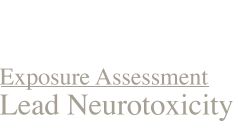 |
||||
CALENDAR |
||

Risk Assessment is another type of causation: predicting whether an exposure, usually in a population rather than a single individual, will increase the risk of developing some adverse health effect, without necessarily determining whether such health effect actually occurs. Risk means that all such exposed individuals are more likely to develop an adverse effect, but it does not mean that any particular individual will or even that the majority of individuals will. Smoking, for example, increases risk of lung cancer from approximately one in 100 to 1 in 10--a signficiant increase. Nevertheless, ninety percent of smokers do not develop lung cancer, even though they are all at increased risk. Risk Assessment is used by regulatory agencies, such as the EPA, to determine how much of a chemical can be released into the environment without causing an unacceptable increase in risk of an adverse effect. 'Unacceptable' is more of a policty decision than a scientific one.
Specific causation analysis can be divided into the following three components:
(1) Hazard Assessment
(2) Exposure Assessment
(3) Health Assessment
(1) Hazard Assessment: what harm can the chemical cause, based on intrinsic toxicity and circumstnaces of exposure, form of chemical (gas, liquid, solid) and susceptibility of individual.
(2) Exposure Assessment how much of the chemical is in a media (air, water, food, soil) available to be taken into the body? Is this a one-time or multiple exposure? Does it occur over a short period of time (acute) or over many months or years (chronic)? How does the length of exposure affect the toxicity of the chemical? How much of the chemical gets absorbed into the body (dose), and where in the body does it end up (distribution and target organ/tissue)?
(3) Health Assessment: what type of health effect develops (or gets exacerbated), and does this occur immediately or after a delay (lag time)? Is this a new effect in the individual or is there a history of this type of problem, made worse by the chemical exposure? Is the individual in a high risk group (in utero, infant, elderly, reduced immune function)? Are there other (alternative) known causes for this problem and were these causes present ?
Exposure Assessment
Beyond these neurotoxic effects lead is also implicated in cardiovascular disease, renal damage and dental caries. Taken together, these early, life long adverse effects of lead exposure, at likely very low levels, underlines the importance and implications of the Rhode Island jury verdict and repercussions it may have on communities throughout the country. Although the latest data remains to be verified, the trend is clearly in one direction and the consequences, both on the individual and on society are so great, that erring on the side of prevention seems the prudent course.
References:
Basha MR, Wei W, Bakheet SA, Benitez N, Siddiqi HK, Ge YW, Lahiri DK, Zawia NH. (2005) J Neurosci. 25(4):823-9.
Bellinger DC and Needleman HL (2003) N Engl J Med 349:500-2.
Canfield RL, Henderson CR Jr, Cory-Slechta DA, Cox C, Jusko TA, Lanphear BP. (2003) N Engl J Med 348:1517-26.
CDC (1975) Statement by CDC. Atlanta, GA US HEW, CDC
CDC (1985) Statement by CDC. Atlanta, GA US HEW, CDC
CDC (1991) Preventing Lead Poisoning in Young Children. Atlanta, GA:Centers for Disease Control.
CDC (2005) Third National Report on Human Exposure to Environmental Chemicals. US HHS, CDC, Alanta, Ga. (http://www.cdc.gov/exposurereport/3rd/pdf/thirdreport.pdf)
Dietrich KN, Berger OG, Succop PA, Hammond PB, Bornschein RL(1993) Neurotoxicol Teratol. 15(1):37-44
Dietrich KN, Ris MD, Succop PA, Berger OG, Bornschein RL. (2001) Early exposure to lead and juvenile delinquency. Neurotoxicol Teratol 23:511-518
Fulton M, Raab G, Thomson G, Laxen D, Hunter R, Hepburn W (1987) Lancet 1: 1221-1226.
Lanphear BP, Hornung R, Khoury J, Yolton K, Baghurst P, Bellinger DC, et al. (2005) Environ Health Perspect 113:894-899.
NHANES (2000) Third National Health and Nutrition Examination Survey, 1999-2000. Phase 3. CDC US DHH.
Needleman HL, McFarland C, Ness RB, Fienberg SE, Tobin MJ. (2002) Neurotoxicol Teratol 24: 711-717.
Nevin R (2000) Environ Res. 83(1):1-22.
Rothenberg SJ, Rothenberg JC (2005) Environ Health Perspect 113:1190-5.
Schwartz J (1994) Low-level lead exposure and children's IQ: a meta-analysis and search for a threshold. Environ Res 65(1):42-5.
